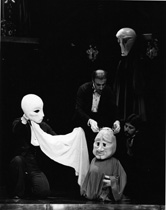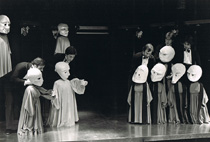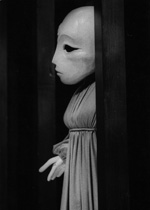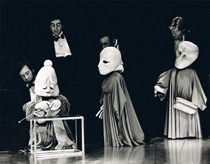 LE SONGE, 1978
LE SONGE, 1978
Texte : August Strindberg
Concept : Felix Mirbt
Marionnettes : Felix Mirbt et Carolyn Davis
Mise en scène : Felix Mirbt, Jean Herbiet
Le Songe fut réalisé en coproduction avec le Centre National des Arts d'Ottawa, le Tarragon Theatre, de Toronto, le Vancouver East Cultural Centre et le Centaur Theatre de Montreal. Il s'agit de la troisième et dernière collaboration de Felix Mirbt avec Jean Herbiet. A l'égal de Woyzcek, Le Songe s'inscrit dans les spectacles les plus marquants de la carrière de Felix.
Voici ci-dessous une sélection d'écrits de Felix Mirbt et de citations directement liés à la pièce Le Songe ou en écho à son travail sur cette production.
A myth relates to humanity in general as a
dream relates to an individual human being.
A dream shows the individual an important
psychological truth about himself.
A myth shows a psychological truth about
humanity as a whole.
A person understanding his own dream,
understands himself a bit better.
A person who comprehends the inner sense of a myth,
creates a connection to the universal and
spiritual questions that life puts to us.
Robert A. Johnson
“Avant d’entrer dans l’au-delà, la femelle monstre dessine un dédale, un labyrinthe appelé “sentier “ (voie). Quand le mort arrive, elle efface tout le patron. Avec des pas cérémonieux, le mort doit restaurer le patron faute de quoi il sera avalé. Mais le patron est le même que celui qu’il a appris à danser encore et encore dans sa jeunesse. C’est un initié. Lorsqu’il complète le parton, il est autorisé à continuer à danser dans la caverne.”
Gertrude Rachel Levy, The Gate of Horn
QUELLE EST LA RAISON DE TOUT CELA ?
- La réflexion, la planification, la construction
C’est peut-être le rituel de la préparation, peut être que c’est le chaman en moi. Mon urgence, mes sens me disent de réunir ceux d’en haut et ceux d’en bas et de les emmener à communiquer avec nous, les humains. Et je retourne aux contes de fées, le point de départ rassurant, la forme toujours ouverte qui permet à tous d’entrer, de participer et de ressortir.
Mais il y a plus que la vanité humaine ou la tentative artistique. Il y a une espèce de fièvre suicidaire. Je sais que je dois aller y aller, sur cette scène et avant d’y arriver (et je sais que j’y arriverai) je sens que je vis une mort ( I feel like dying a death).
Et comme les Gardiens ont effacé une partie de mon chemin, j’aurai à me rappeler ma danse pour me rendre de l’autre côté.
DREAMPLAY/LE SONGE (1978-80)
A.Strindberg
Agnes, daughter of the god Indra, comes down to earth to discover whether or not man is happy. She will want to see all, know all, live all! She will even get married, in order to taste love, and she will give birth to a child. Disillusions! Of all men on earth, only the Poet, who can escape reality, will be worthy of her esteem and keep her admiration and love. Agnes will return to her father to sing the agony of mankind.
For Agnes, Le Songe is a startling look at mankind. For us, it is a step into the fascinating world of dreams.
Agnès, la fille du dieu Indra descend sur terre. Elle a pour mission de découvrir si l'homme est malheureux. Elle voudra tout savoir, tout voir, tout vivre! Elle se mariera même, afin de connaître l'amour, et metra au monde un enfant. Désillusions! De tous les hommes de la terre, seul le Poète, celui qui "bat de l'aile au-dessus de la glaise", aura su finalement garder toute son estime, son admiration et son amour. Et elle s'en retournera chez elle, vers son père, porter la longe plainte des hommes.
"(...) Oh! Je sens à présent la douleur de vivre
Je m'en vais
Je veux partir et je veux rester
C'est ainsi que les hommes vivent!
Mon coeur est écartelé.
Adieu, (...)"
CONCEPT:
We continued the idea from Woyzeck to separate the VOICES from the MANIPULATORS. But instead of male and female character voices, here we went purely for sound: each scene was read by ONE voice only, based on my choice of vocal level: soprano - alto - tenor and bass ( sound coding).
And here we explored different modes: separate heads in four stages of abstraction (form-coding ) could be chosen freely for the eighteen bodies of distinctly different color (color coding) going once around the color wheel. The manipulation was highly stylized. So we did not start out from the aspect of interpretation but tried to create a purely mathematical schemata. Yet it all created its own interpretation.
LE SONGE - December 11, 1998
We felt pretty good - we, les boys - after Woyzeck and De La Manipulation De Dieu. I remember the ever re-occurring pain the stomach ache setting in. The conceptual work proceeded, the building commenced and everything was running its course. This, and I am talking about a physical state here, felt good: you take a raw mask, perhaps a body or any configuration and try to move it. And it works. The rawness of the material has a purity which we always paint over, the destined body, cloth, wood or whatever is intended, moves along or has a life of it’s own. You feel and SEE the product, the constellation before you, ahead of you.
And than you all stand there and confront the final result, the “art work” you just had created over the passed months. And nothing, absolutely nothing inspires you, hits you. The memory of recent delights in the workshop simply has nothing to do with the reality of the moment. It is an endless moment. Dead. Fear and an abyss of nothingness. You feel sick. And it is not your stomach only.
We somehow conveniently forget that state, that moment. I am suddenly confronted with the audacity of the venture, the audacity of thinking, that I can just go ahead and create (the word `create’ has to be pronounced nasally). Yet, when I try to define, I might come up with an excuse, which implies an accusation (?) as well: a neglectful oversight. All that had been perceived by brain, pencil and shop work now has to shift gears and enter a totally new space of thought (try a better phrase) or work or perception.
Movement and sound. All your assembled vocabulary has to be either forgotten or has to be translated. That in itself is pain. But worse, the realization of it is veeery slow.
An anecdote:
when we were in above described state for the Dreamplay/Le Songe, we hang around for days in a daze. At the NAC at that time there performed an Indian Dancer. She did a solo program of Katakali or some similar sort of dance. On opening night the Ottawa-Indian community visited after the show backstage. We were still in the rehearsal hall and had left the doors open. And so we invited the people who looked in curiously. I believe it may have been Mme Ambassador herself who knelt down behind Agnes and started to do the arm movements of a dancer. It looked gorgeous to us. From there on, for the entire time of the show, we sat in on the dancers warm-up. We decided to have Indian elements in the show (which was easy, Agnes, the heroine of the Dreamplay was the Daughter of Indra, the highest god). And so dreamy Michael was allowed to play the Sitar in one section, which, by the way had always to be tuned by Bob - talk about non-functional and ritual - For Dreamplay the above happening allowed us a way in, a first step to be copied, a step to eventually be discarded.



